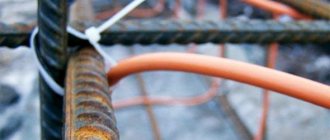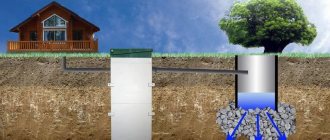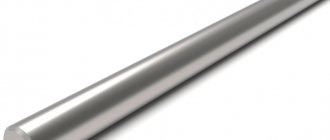Author of the article:
If it is necessary to mount a massive and heavy object or structural element on a wall or ceiling, the most reliable option would be to fasten it with anchor bolts. These are hardware designed for use in the most severe conditions. For example, they are used to secure fiber optic wires stretched between buildings. They create significant loads that the anchors can easily withstand.
The use of anchor bolts is justified if two conditions are met:
- heavy load needs to be secured;
- the base is made of hard, dense material.
Anchors can only be used on concrete, solid brick, natural stone, and other dense building materials. Low-density material will not hold such fasteners. Let's look at the main types of anchor bolts, their features and installation methods.
Anchor bolts - types and principle of operation
Content
Anchor bolts - if we consider the principle of operation of the two main types of fasteners - anchor and dowel, then the anchor has a significant advantage. The metal anchor, in addition to the frictional force, is held at the base using a “stop” in the form of a kind of anchor, obtained due to the spacer part of the shank. To friction is added the force of resistance to the destruction of the material.
There are also chemical anchors; instead of a metal sleeve, they use quick-hardening adhesive compounds that are introduced into the hole before installing the anchor bolt. The result is a monolithic connection with the base.
There is a large range of anchors on the market, but they can all be divided into several classes.
What is an anchor bolt from Wikipedia
An anchor (German Anker - anchor) is a fastener that is fixed in a load-bearing base and holds any structure.
The following types of anchors are distinguished:
Foundation bolt
Bolt molly
ru.wikipedia.org/wiki/Anchor_bolt
Working principle and application
Concrete is a porous material with a heterogeneous structure. And in the places of fastening, various forces appear - twisting, bending, shearing, shearing, compression, tearing. The concrete anchor takes over them, distributing them together with the supporting structure.
Basic principles of operation of concrete anchors:
- At the moment of interaction between the base material and the anchor, a frictional force appears - the expansion is carried out with dowels and metal collets.
- When, at the depth of anchoring, the material provides resistance to fracture or crushing - due to collet bushings on the fasteners, the curved shape of the rod, and expansion.
- Loads at the point of contact between the base and the rod are compensated by tangential stresses during embedding or gluing - this is how smooth, adhesive anchors work.
Anchors for concrete can be of different designs, types, sizes. They are made from special steel according to GOST and coated with a layer of anti-corrosion agent. The rod can be 6-20 millimeters in diameter and up to 220 millimeters long.
Any anchor includes the following parts:
- The bolt itself
- Cone with a layer of thread inside
- Bushing with special cutouts
Anchors perform a constructive or load-bearing function. The load-bearing function is implemented in cases of connecting floor slabs, beams, columns, balcony consoles, landings and flights, finishing and wall panels, engineering equipment, communications, hoods, ceiling lamps, etc. Anchors are also used for installing joists on concrete or hollow-core floors. They are used to attach electrical equipment and hanging furniture to walls.
Structural fasteners are used to counteract the displacement of parts of the assembly if their stability is guaranteed by their own weight; anchors are also relevant when straightening in construction.
Anchor bolt with nut - how to fasten
Essentially, it is a stud with a nut and washer that is screwed into a coupling (threaded sleeve). Therefore, it can be called an anchor bolt with a nut or a stud anchor. We study in detail how to fasten anchor bolts with a nut ourselves and use them.
On one side, a nut and washer are screwed onto the stud, and on the other, there is a “wedge” in the form of a cone. In the wide part the wedge corresponds to the diameter of the coupling, in the narrow part it corresponds to the pin. The coupling on the wedge side has a notch and longitudinal slots.
Installation is quite simple, even a beginner can understand how to attach anchor bolts with a nut.
Mounting diagram
A hole for the coupling is drilled in the base and cleaned of dust. The part is hung on the anchor, inserted into the hole and hammered in with gentle blows of a hammer until it stops. Then tighten the nut a few turns.
Screwing onto the stud, the nut “unscrews” it from the coupling; as a result, the wedge expands the coupling along its entire length with slots.
Anchor bolts are made from galvanized steel. Used for concrete, stone, solid brick.
There is an “improved version” of such an anchor - a double-spacer one.
It has two movable couplings with slots, one of which fits into the other with a cone. When the nut is screwed in, the shank pushes one sleeve onto the other. The first one expands with a wedge cone and itself expands the middle coupling, forming two fastening belts.
Types of anchor fastening
Based on the installation method, they are divided into three categories:
- fastening due to mechanical changes in structural elements;
- with the addition of adhesive fixing fillers;
- using vibrocaulking.
Based on the type of fastening, they are divided into the following categories:
- wedge;
- bushing;
- expanding;
- driving;
- special.
The first type is structurally made in the form of a metal rod, at the end of which a cone with a spacer sleeve is formed. On the opposite side there is a thread. To improve consumer characteristics, the fixing nut is installed in tandem with a washer. The rod itself is inserted into a metal sleeve. When the bolt is screwed in, the bushing becomes wedged.
With a sleeve anchor, the sleeve is comparable to the length of the rod. A wedge head is made at its end. At the time of installation, the sleeve expands. Thanks to this, its diameter increases and it fits more tightly to the walls of the hole. This fastener is used in more porous building materials: lightweight and porous concrete, ceramic bricks, building materials with various additives.
One of the varieties of such an anchor is an expansion bolt. It has a more complex design due to the use of a 4-leaf spacer sleeve. For the most reliable fastening, an expansion spring with an expansion nut is inserted into the bushing. Changing the shape of the bushing can significantly increase the engagement force and load-bearing capacity. This fastening system does not create increased internal stresses in the contact zone. This significantly increases the service life of the entire mount. The expansion anchor is expensive. Therefore, it is used only by professional builders in critical construction areas. Where it is necessary to fasten the part to masonry made of cellular concrete or hollow brick.
The drive-in anchor gets its name from the way it is installed. It is secured using impact tools: a hammer, a mallet, a rotary impact drill.
To solve non-standard problems, special anchors are manufactured. These include:
- frame anchors with PVC sleeve;
- self-tightening bolts;
- anchors for hollow structures;
- some types of screw anchors;
- fasteners for geogrids.
Modern manufacturers offer a wide range of anchors for various building materials. The main types are given below.
With nut
An anchor fastener with a nut is one of the most common among such fixing devices. Its popularity is due to its simplicity of design, reliable connection and low price. Structurally, it consists of three parts:
- screw with conical thickening;
- steel tube (equipped with slots for more efficient expansion);
- fixing nut (when screwed onto the bolt, it retracts).
The principle of operation is quite simple. Due to the rotation of the nut, the bolt moves along the rod. This causes the tip of the rod to expand. The further the nut moves, the stronger the connection.
An anchor of this design is used for fastening parts in wall and ceiling structures. Permitted materials for use are dense concrete, solid silicate or ceramic bricks, and various types of natural stone. The main overall dimensions are the outer diameter of the rod, the length of the bolt, and the metric size of the nut. In practice, anchors with a diameter of 6 to 28 millimeters are used. In length, manufacturers produce products from 60 to 300 millimeters.
Wedge
This anchor bolt is a modification of the design discussed above. The main difference is the sleeve placed at the end of the rod, which, when expanded, creates the necessary effect. At the other end there is a nut and lock washer screwed on.
The scope of application coincides with the anchor bolt and nut. It is made from carbon or stainless steel. The galvanizing process is used to protect against corrosion.
The main mechanical characteristics are:
- geometric dimensions (the diameter of the bolt is made from six to twelve millimeters, the length of the entire structure is from forty to one hundred and twenty millimeters);
- permitted thickness of the product that can be attached (no more than twenty millimeters);
- thickness of the bearing surface (not less than 53 mm);
- the value of the pulling force (with proper installation it reaches 6 kN).
Installation is carried out using a standard set of tools. To understand how to fasten an anchor bolt of this type, it is enough to familiarize yourself with the method of fastening conventional anchors. A part secured with a wedge anchor can withstand heavy loads. This is possible due to the creation of high internal stress, which significantly increases the value of the tearing force.
Hex head
To fasten structures with heavy weight to surfaces with increased hardness, use an anchor bolt with a hex head. It is especially widespread during repair and design work, in which the aesthetic design of fastening elements is of great importance. This is possible because during installation the rod (stud) does not move in the opposite direction.
The design difference is the presence of a hexagonal head. When installed, it rotates along the threads of the spacer bolt, which causes the bushing to expand. The material used for manufacturing is yellow-passivated galvanized steel. This provides good anti-corrosion protection.
It is advisable to tighten such a bolt using an appropriate spanner or socket wrench. The hexagonal head design allows the effective use of electric tools, such as a wrench. When installing it in the hole, you must ensure that there are no distortions or displacements.
Drums
A driven or impact anchor bolt is used at the initial stage of construction or the rough finishing stage for fastening massive structures. With its help, heavy parts are fastened up to load-bearing structures, routes are laid for cables and plumbing equipment, and suspended elements of building structures are mounted. The main condition for use is the required density of the base where the anchor is installed.
The main characteristics are:
- the length of the entire bolt structure (manufacturers produce products from 25 to 50 mm);
- outer diameter (the size is determined by the manufacturer, but according to established standards it can reach 20 mm);
- the thickness of the part that is fixed is not standardized;
- the minimum thickness of the base in accordance with established standards must exceed 100 mm;
- The magnitude of the pullout force, depending on the dimensions of the bolt and the density of the base, varies from 3.9 to 12.6 kN.
To ensure the reliability of the connection, you should understand the principle of operation and imagine how to correctly drive anchor bolts?
Fastening the part with a driven anchor bolt is carried out in the following sequence:
- a hole of the required diameter of a greater length than the anchor itself is drilled in the load-bearing surface;
- the hole is cleaned of any dirt and dust that has formed;
- using a hammer, hammer the sleeve into the hole (under the influence of the impact load, the split part of the anchor expands and fits tightly to the walls of the hole);
- screw in a bolt or pin (fastening the required part).
The anchor bolts must be driven in perpendicular to the fastening surface for the entire length of the bolt.
Four-segment
Anchors of this type are used for fastening structures with large weight and size characteristics. The presence of four segments in the sliding part gives the fastening increased reliability. It has an increased degree of wedging and is used not only in solid materials, but also in materials with a porous structure.
The anchor sleeve is made of galvanized steel in the form of four independent segments. On one side the segments are fastened with a ring. On the other hand, the segments are fastened with a restraining spring. A spacer element is provided to increase efficiency.
When a bolt is screwed into an anchor, it moves down the anchor. At this moment wedging occurs. Thanks to this design, reliable fixation is ensured along the entire length of the anchor.
Screw
This type of bolts is made from rebar. It represents a long screw with a large pitch thread. Fixation in the prepared hole is achieved through the hardening of mineral, polyester or other special fillers. Screw anchors are used from mining to capital construction. When they are fixed in a brick wall, it is possible to obtain a reliable connection. The kit includes: screw rod, washer, spherical nut.
The use of special fastening fillers ensures reliable and durable fastening.
Wedge anchor - how to attach
This type can be considered as a modification of the previous one. The coupling is made in the form of a movable short sleeve-ring at the end of the pin on the shank (wedge) side.
Wedge pin anchor
The principle of operation is similar, there is a slight difference - it does not require precise drilling to the depth of the hole and cleaning it from dust. The hole is drilled with reserve, the anchor is inserted to the required depth and the nut is screwed in, pushing the sleeve apart with the shank.
Calculation of anchors
Performing a pull-out test on connections is often performed on site. The permissible load will depend on the base material, for example:
When installing massive structures at height, the required tensile strength should be about 700 kg, which is why experts recommend using chemical types of anchors for such fastenings. When using concrete or brick as a base, the average load is about 350 kg, this value is sufficient for fastening medium and heavy structures. When using foamed concrete, the load it can withstand will be about 250 kg. In addition to calculating the load-bearing capacity of the elements used, the correct tightening torque of threaded connections must be ensured. If the tightening is insufficient, there may be no frictional force in the connection; if the recommended values are exceeded, there is a possibility of material destruction due to excess pressure on the base.
Anchor stud with hex head
This is a classic bolt and washer that screws into a coupling with longitudinal slots at the end. The tail cone-shaped nut serves as a spacer element.
Installation is standard - drill a hole, clean it, insert an anchor with a suspended part and lightly tap it. All that remains is to tighten the anchor bolts a few turns - the nut fits into the coupling with a cone and pushes it apart.
Anchor stud - installation diagram
The scope of application is the same as that of previous types - fastening heavy structures to a base made of concrete, stone and solid brick.
This type of bolt may end in a ring or hook. They allow you to simply hang structures after installing the anchor, otherwise there are no differences.
Four-segment
The design of such an anchor bolt does not include a wedge part, and the expansion of the spacer sleeve, divided into four segments by longitudinal slots, occurs when the bolt is screwed in, which moves the tetrahedral element in its internal cavity. The four lobes, which are formed by slots on the side surface of the spacer, are initially compressed and form the conical tip of such a bolt. When a bolt is screwed in, which moves a threaded tetrahedral element inside the spacer sleeve, the segments expand, which allows the anchor to be securely fastened in the mounting hole.
The fairly large expansion of the lamellas of this anchor ensures responsible fastening in various types of materials
The petals of such a product open quite wide and this happens very carefully. That is why it can be mounted in porous and even hollow materials. The threaded element, which is usually not supplied with such an anchor product, can be a bolt with a regular hex head or a bolt whose upper part is crowned with a ring or hook.
Installing a 4-segment anchor
Impact anchor bolts - how to fasten?
This sample combines the functions of an anchor and a nail.
Impact type stud anchor
It consists of a hollow metal rod, one end of which is made in the form of a stud with a thread for a nut and washer, the other is a sleeve with a four-leaf spacer.
Installation: how to fasten an anchor bolt - you need to drive an anchor bolt into the hole in the base, into which, in turn, you drive a nail. The petals of the sleeve diverge. The nut serves only to secure the part being hung.
What is an anchor
Initially, this is the name given to the type of fastener that is held in the mounting hole due to the expansion (wedging) of a special element (spacer sleeve or sleeve). The powerful friction forces that arise prevent the fastener from being removed from the mounting socket. This is the so-called mechanical anchor.
Now there is another type of anchor - chemical. It is attached using an adhesive composition made on the basis of synthetic resin. The mounting hole is filled with this composition, then one or another fastener is screwed into it: a bolt, a pin or fittings. Obviously, using “chemistry” we have a wider selection of fasteners.
Four-segment expansion anchor
According to the principle of operation, this type is closer to an anchor with a nut or hex head. Although it does not have a wedge or cone-shaped nut on the shank of the stud or bolt, expansion occurs due to the bolt itself being screwed into the hollow sleeve, which moves the internal tetrahedral element.
Four-segment anchor bolt
The anchor consists of a cylinder with four slots that end in a narrow ring. The slats are held in place by a flat spring, after which the slots are shaped like a wedge. Moving, the tetrahedral threaded element pushes these wedges apart.
Anchor stud installation diagram
The bolt is not included in the kit, but is selected depending on the size of the structure being hung.
In addition to the bolt, you can screw a bolt with a hook or ring into the expansion anchor. These modifications come with them.
Due to the wide opening of the wedge lamellas, expansion anchors can also be installed in weak foundations - hollow (slotted) bricks, gas or foam concrete blocks.
The principle of operation of an anchor bolt: what are its advantages
There are a number of advantages when using a quality anchor:
- bolts can withstand high loads, so they have proven themselves in the construction industry. Products in demand on the market due to their load capacity;
- an expanded range of bolts, so it is easy to choose the appropriate option depending on the specifics of the installation;
- performance properties of carbon steel. Durable material does not corrode;
- ease of installation. No special equipment or a lot of time is required to install bolts according to the installation rules;
- using anchor bolts you can strengthen existing structures;
- resistance to constant exposure factors. For example, when vibrating, parts do not loosen or bend and retain their properties.
Disadvantages include the cost of anchor bolts and the need to create a hole in the base.
Drive-in anchor - how to attach an anchor bolt
One of the easiest types of anchor to install.
The device is a threaded bushing that has slots at the driven end, a conical internal shape and a wedge.
Installation - a hammer anchor is inserted into the prepared hole and, using a special impact attachment, the cut part is pushed apart with a wedge. When the anchor bolts are screwed in, the petals spread even wider, increasing grip.
Made from galvanized steel or brass.
Anchor fastening types and features of anchors application tightening technique
Using a kit for fastening to anchor supports, it is possible to install the coupling on power transmission line supports and wind the free length of the optical cable onto the frame.
This type of connection is used to ensure the safety of work performed at height according to the permit. To carry out such activities, a permit is required, issued by a labor protection specialist and endorsed by officials from among the managers, and the work itself is carried out by a group of workers under the guidance of foremen and supervisors. The most widely used are anchor bolts that have a spacer operating principle based on the expansion of the rear section of the sleeve when a cone-shaped sleeve is screwed into it. Among the well-known types of anchors, experts call driven, expanding, chemical, expansion and wedge structures. Each of them ensures reliable retention of the fastening part due to the use of the friction force between the contact surfaces of the bolt and the installation area, the thrust force, which ensures compensation of the effective stress by the resistance of the metal of the product. Increasing the diameter of the spacer sleeve when screwing a bolt into it ensures a reliable connection due to the combined action of thrust and friction forces.
Experts emphasize the importance of choosing the right type of anchor, based on studying the manufacturer’s documents that determine the specifics of each type of product. since the reliability of the system largely depends on the building material used at the point where the bolt is attached. Proper execution of fastening is necessary to prevent damage during operation of the parts that make up the connection and to ensure comfortable work in the support. Such a connection will ensure safety when working at heights, fastening heavy static (horizontal bars) and dynamic (diamond drilling rigs) structures.
This is interesting: Aluminum electrodes - types and their features
Screw anchor
Has a special design. The slots in the sleeve are not cut completely and end with a ring with a nut. Closer to the head and in the middle of the liner, the lamellas are weakened. When tightening the screw, the nut moves and pushes the lamellas apart in the middle.
Specially designed for weak and hollow substrates. It can be produced not only with a screw, but also with pins, hooks, and rings.
Anchor bolt with ring
Screw
The design of the screw fastener, which is very easy to use, differs from all other anchor-type products. The slots on the spacer sleeve of such an anchor, which ensure its expansion during installation, are made in its middle part and have a weakened design. The lower part of such a sleeve is a nut into which the anchor bolt is screwed, compressing it along its length and ensuring the opening of the petals.
Screw anchors are called anchors of different designs.
The process of installing a screw anchor bolt can also be seen in the video. Such an anchor can be fastened in “weak” materials: porous concrete, brick, etc.
General recommendations
In order to correctly install anchor bolts, it is necessary to take into account the type and strength of the base, select the optimal type of anchor for a particular part and determine its load capacity.
And although some types do not require high precision hole drilling (for example, expanding), the more accurate it is, the more reliable the anchor’s adhesion to the base.
Information to note : Liquid glass , Solvent 646, white spirit.
Anchor bolt. Installation, principle of operation.
Pros and cons of use
The main advantages of using anchor bolts for concrete are maximum reliability and strength of structures. Anchors can withstand enormous loads and guarantee high-quality fastening in concrete with characteristics that cannot be achieved using other types of fasteners.
The main advantages of concrete anchors:
- Resistance to deformation and corrosion
- Lightness, simplicity and high speed of installation
- Resistance to dynamic and static loads of various types
- Large selection of anchors by length, diameter, type of fastening, load, function, shape, material, etc.
Selecting an anchor bolt for a particular task is not difficult. There are no obvious disadvantages to this type of fastener. Unless you need to remember some features: the importance of accurate markings, the correct selection of drills for concrete and determining the depth of the hole, the need to use a certain set of tools.











